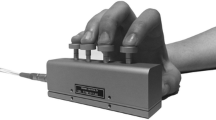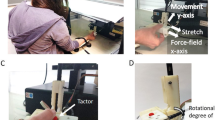Abstract
Objective
To reveal the force mechanism for therapeutic effect of pushing manipulation with one-finger meditation.
Methods
A total of 15 participants were recruited in this study and assigned to an expert group, a skilled group and a novice group, with 5 participants in each group. Mechanical signals were collected from a biomechanical testing platform, and these data were further observed via similarity analysis and cluster analysis.
Results
Comparing the force waveforms of manipulation revealed that the manipulation forces were similar between the expert group and the skilled group (P>0.05). The mean value of vertical force was 9.8 N, and 95% CI rang from 6.37 to 14.70 N, but there were significant differences compared with the novice group (P<0.05). The result of overall similarity coefficient cluster analysis showed that two kinds of manipulation forces curves were existed between the expert group and the skilled group.
Conclusion
Pushing manipulation with one-finger meditation is a kind of light stimulation manipulation on the acupoint, and force characteristics of double waveforms continuously alternated during manual operation.
Similar content being viewed by others
References
Zhu DC. Forty cases of elderly suffered with insomnia treated by method of pushing manipulation with one finger to induce yang conducting to yin. Geriatr Health Care (Chin) 2004;10:114–115.
Tian HZ, Peng DZ. Clinical observations on 50 cases of migraine treated by pushing manipulation with one finger. J Chengdu Univ Traditional Chin Med (Chin) 1999;22(4):57–58.
Yan XH, Yan JT, Gong L. The origin and research advances of pushing manipulation with one finger meditation. Henan Tradit Chin Med (Chin) 2009;29:515–518.
Yan JT, ed. Tuina therapy. Beijing: China Press of Traditional Chinese Medicine; 2009:128–129.
Wang GC, Bi YS, Zhang SF. Preliminary analysis of dynamic curve with Yizhichan manipulation, rolling manipulation, internal strength massage and acupoint pressing massage. J Shandong Univ Tradit Chin Med (Chin) 1982;6(3):67–68.
Fang L, Fang M. Biomechanical progress of normalized manipulation. J Hubei Coll Tradit Chin Med (Chin) 2010;4(12):60–62.
Fang L, Fang M. Research progress on the standardization of Chinese Tuina therapy: a short review. Chin J Integr Med 2013;19:68–72.
Qin J, Zhao P, Liu JY, Zhong HG, Li Y, Ma YZ, et al. Biomechanical analysis of mechanical measurement system on rolling manipulation. J Tradit Chin Orthoped Traumatol (Chin) 2004;16(12):4–5.
Lu J, Cao JF, Fang L, Ma LL, Zhang DS, Fang, et al. Energy analysis of rolling manipulation force signal based on wavelet transform. J Med Biomech (Chin) 2010;25:439–443.
Qiu GC, Li Y, Wu X. The clinical significance of Contact pressure measurement in rolling manipulation. J Navy Med (Chin) 2007;28:56–57.
Wang H, Zhao C, Wang JG, Dong HY, Tan T. Nonlinear analysis on graph of rolling manipulation. J Tianjin Univ Tradit Chin Med (Chin) 2008;27(2):66–68.
Shao XN, Wei GW, Chen MR. Establishment on the reference atlas and Quality Control Figure of Rolling and rotating maneuvers. Guiding J Tradit Chin Med Pharm (Chin) 2005;11(11):5–7.
Lu J, Cao JF, Fang L, Zhang DS, Ma LL, Fang Z, et al. The biomechanical research of rolling manipulation-kinematic measurement and analysis. Prog Biomed Eng (Chin) 2010;31:142–148.
Acknowledgements
We thank the Research Institution of Tuina, Shanghai Academy of Traditional Chinese Medicine, for providing laboratory equipment. Meanwhile, this work was also supported in part by Shanghai University of Traditional Chinese Medicine 085 project.
Author information
Authors and Affiliations
Corresponding author
Additional information
Supported by the National Science Foundation for Distinguished Young Scholars of China: Science of Tuina (No. 81025022)
Rights and permissions
About this article
Cite this article
Fang, L., Fang, M. & Guo, Mm. Study on Force Mechanism for Therapeutic Effect of Pushing Manipulation with One-Finger Meditation Base on Similarity Analysis of Force and Waveform. Chin. J. Integr. Med. 24, 531–536 (2018). https://doi.org/10.1007/s11655-016-2275-x
Accepted:
Published:
Issue Date:
DOI: https://doi.org/10.1007/s11655-016-2275-x




